Academic Plagiarism Essay: Types, Factors, Consequences, and Examples
VerifiedAdded on 2022/12/30
|6
|1355
|97
Essay
AI Summary
This essay delves into the multifaceted issue of academic plagiarism, commencing with a clear definition and highlighting its significance in both academic and professional spheres. The main body of the essay meticulously examines various types of plagiarism, including direct, hired, borrowed, self, and mosaic plagiarism, providing distinct examples to illustrate each form. Furthermore, the essay explores the underlying factors that contribute to plagiarism, such as the desire for high grades, fear of failure, time constraints, and lack of interest in the assigned work. The consequences of plagiarism are also thoroughly discussed, emphasizing the potential damage to reputation, mental well-being, and career prospects, along with the possibility of legal repercussions. The essay concludes by underscoring the critical importance of understanding plagiarism to safeguard academic integrity and uphold ethical standards in both educational and professional contexts. References to relevant books and journals are provided to support the discussion.
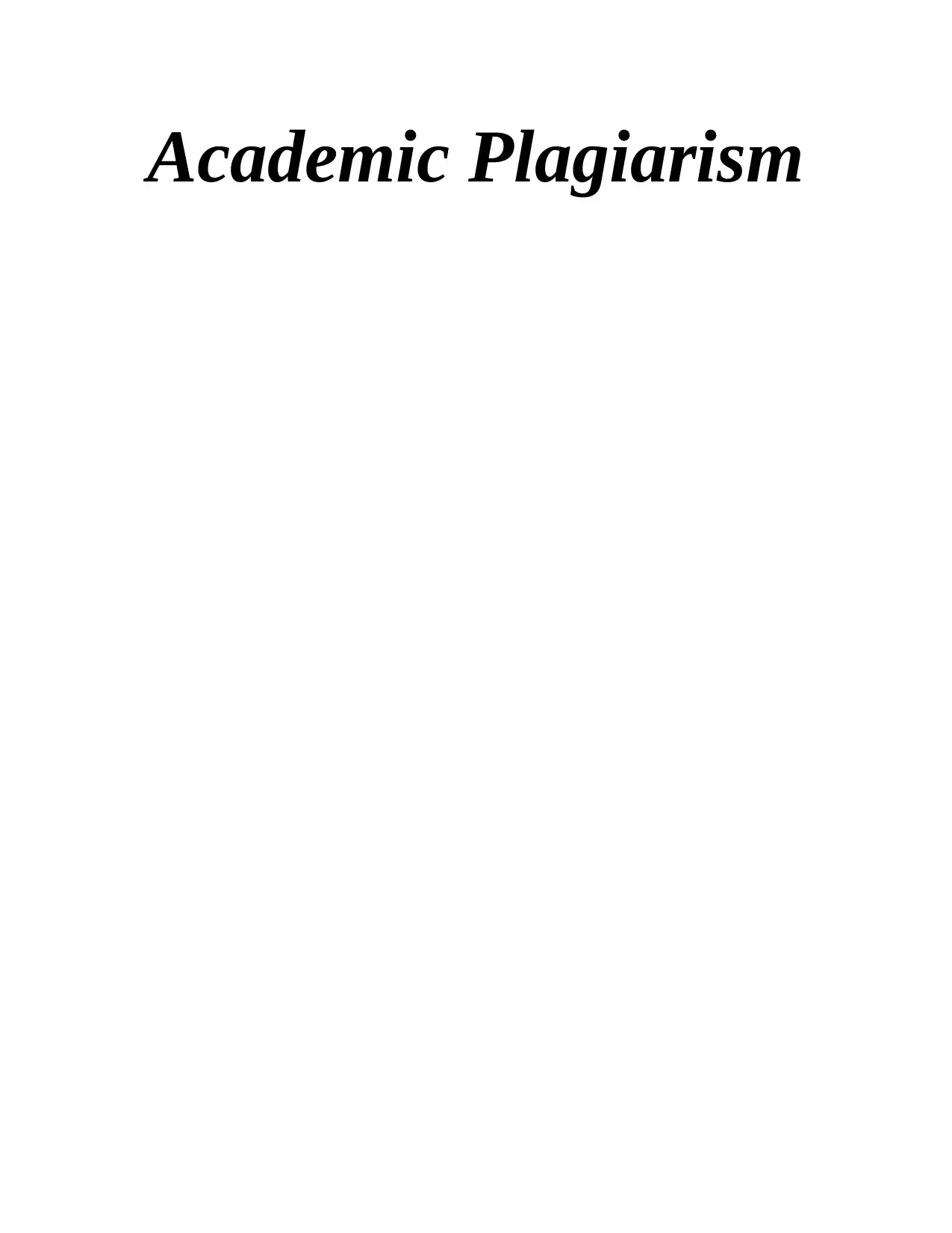
Academic Plagiarism
Paraphrase This Document
Need a fresh take? Get an instant paraphrase of this document with our AI Paraphraser
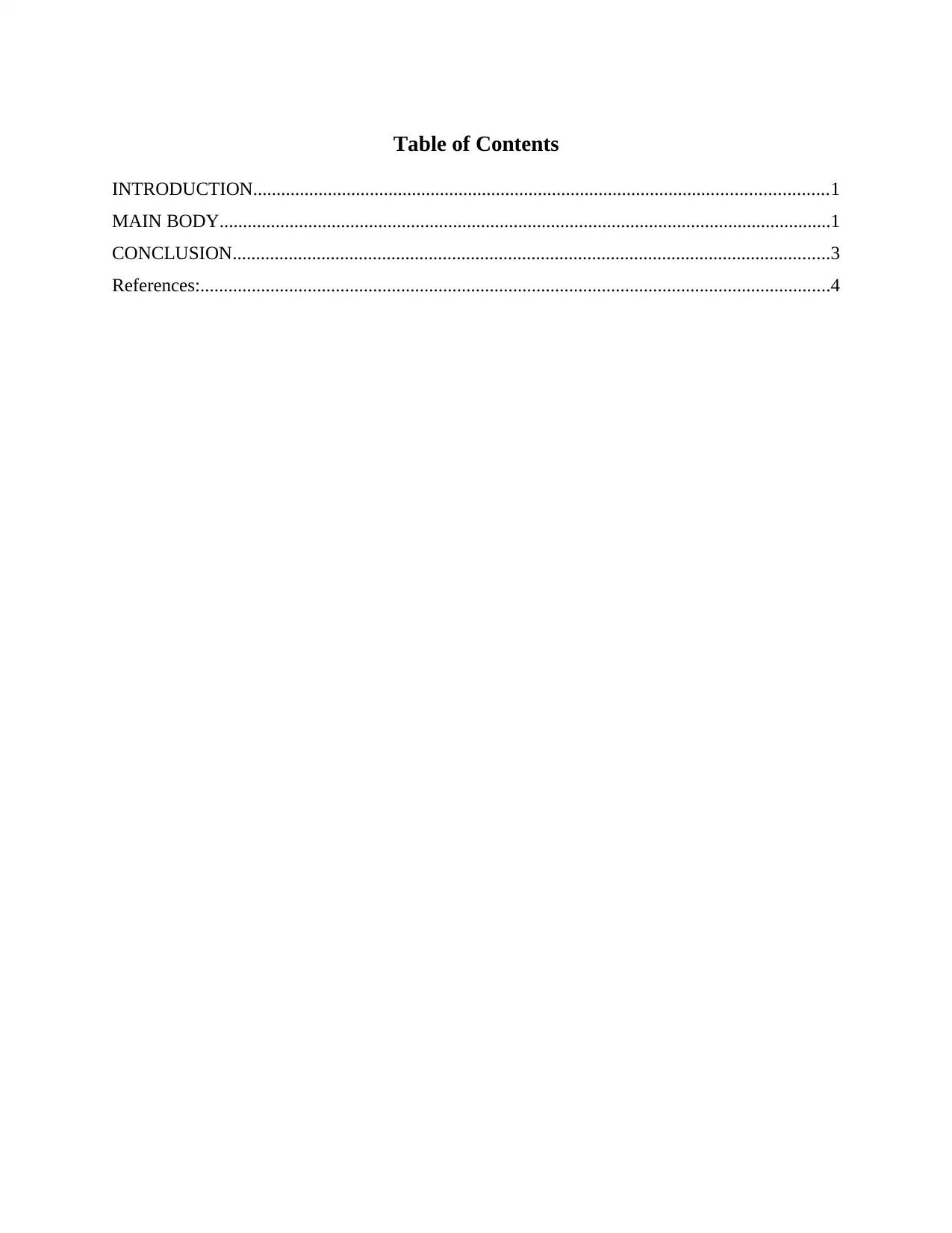
Table of Contents
INTRODUCTION...........................................................................................................................1
MAIN BODY...................................................................................................................................1
CONCLUSION................................................................................................................................3
References:.......................................................................................................................................4
INTRODUCTION...........................................................................................................................1
MAIN BODY...................................................................................................................................1
CONCLUSION................................................................................................................................3
References:.......................................................................................................................................4
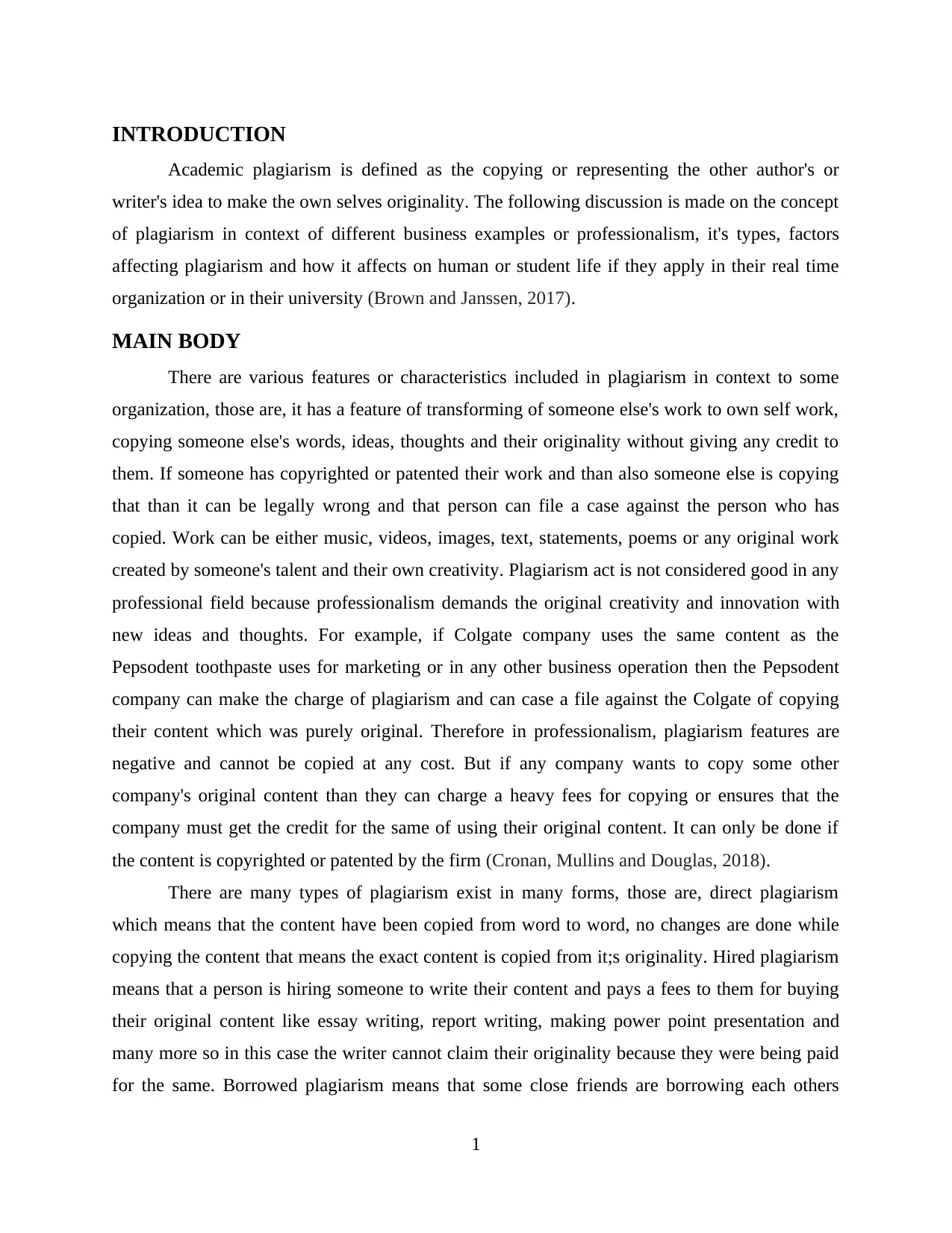
INTRODUCTION
Academic plagiarism is defined as the copying or representing the other author's or
writer's idea to make the own selves originality. The following discussion is made on the concept
of plagiarism in context of different business examples or professionalism, it's types, factors
affecting plagiarism and how it affects on human or student life if they apply in their real time
organization or in their university (Brown and Janssen, 2017).
MAIN BODY
There are various features or characteristics included in plagiarism in context to some
organization, those are, it has a feature of transforming of someone else's work to own self work,
copying someone else's words, ideas, thoughts and their originality without giving any credit to
them. If someone has copyrighted or patented their work and than also someone else is copying
that than it can be legally wrong and that person can file a case against the person who has
copied. Work can be either music, videos, images, text, statements, poems or any original work
created by someone's talent and their own creativity. Plagiarism act is not considered good in any
professional field because professionalism demands the original creativity and innovation with
new ideas and thoughts. For example, if Colgate company uses the same content as the
Pepsodent toothpaste uses for marketing or in any other business operation then the Pepsodent
company can make the charge of plagiarism and can case a file against the Colgate of copying
their content which was purely original. Therefore in professionalism, plagiarism features are
negative and cannot be copied at any cost. But if any company wants to copy some other
company's original content than they can charge a heavy fees for copying or ensures that the
company must get the credit for the same of using their original content. It can only be done if
the content is copyrighted or patented by the firm (Cronan, Mullins and Douglas, 2018).
There are many types of plagiarism exist in many forms, those are, direct plagiarism
which means that the content have been copied from word to word, no changes are done while
copying the content that means the exact content is copied from it;s originality. Hired plagiarism
means that a person is hiring someone to write their content and pays a fees to them for buying
their original content like essay writing, report writing, making power point presentation and
many more so in this case the writer cannot claim their originality because they were being paid
for the same. Borrowed plagiarism means that some close friends are borrowing each others
1
Academic plagiarism is defined as the copying or representing the other author's or
writer's idea to make the own selves originality. The following discussion is made on the concept
of plagiarism in context of different business examples or professionalism, it's types, factors
affecting plagiarism and how it affects on human or student life if they apply in their real time
organization or in their university (Brown and Janssen, 2017).
MAIN BODY
There are various features or characteristics included in plagiarism in context to some
organization, those are, it has a feature of transforming of someone else's work to own self work,
copying someone else's words, ideas, thoughts and their originality without giving any credit to
them. If someone has copyrighted or patented their work and than also someone else is copying
that than it can be legally wrong and that person can file a case against the person who has
copied. Work can be either music, videos, images, text, statements, poems or any original work
created by someone's talent and their own creativity. Plagiarism act is not considered good in any
professional field because professionalism demands the original creativity and innovation with
new ideas and thoughts. For example, if Colgate company uses the same content as the
Pepsodent toothpaste uses for marketing or in any other business operation then the Pepsodent
company can make the charge of plagiarism and can case a file against the Colgate of copying
their content which was purely original. Therefore in professionalism, plagiarism features are
negative and cannot be copied at any cost. But if any company wants to copy some other
company's original content than they can charge a heavy fees for copying or ensures that the
company must get the credit for the same of using their original content. It can only be done if
the content is copyrighted or patented by the firm (Cronan, Mullins and Douglas, 2018).
There are many types of plagiarism exist in many forms, those are, direct plagiarism
which means that the content have been copied from word to word, no changes are done while
copying the content that means the exact content is copied from it;s originality. Hired plagiarism
means that a person is hiring someone to write their content and pays a fees to them for buying
their original content like essay writing, report writing, making power point presentation and
many more so in this case the writer cannot claim their originality because they were being paid
for the same. Borrowed plagiarism means that some close friends are borrowing each others
1
⊘ This is a preview!⊘
Do you want full access?
Subscribe today to unlock all pages.

Trusted by 1+ million students worldwide
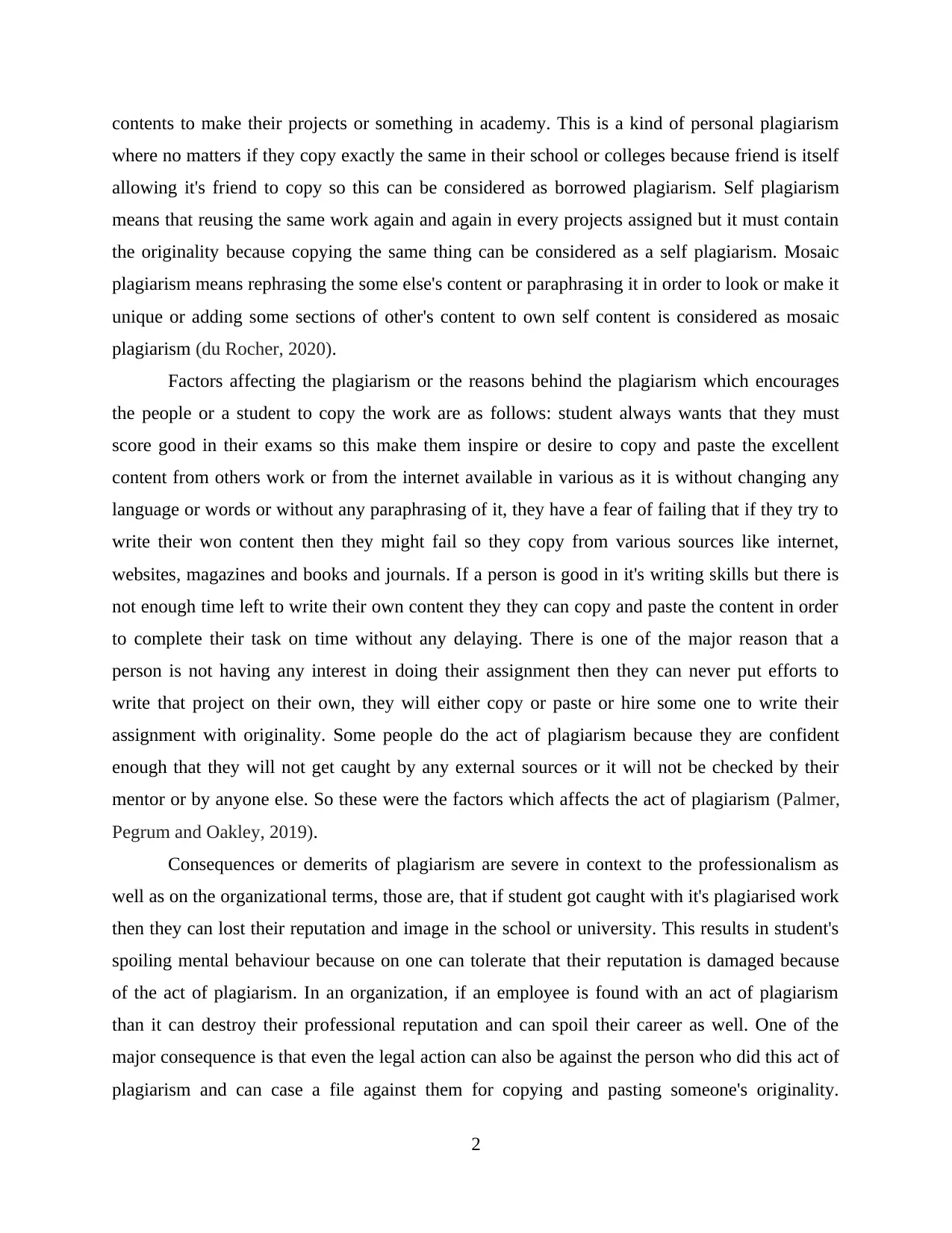
contents to make their projects or something in academy. This is a kind of personal plagiarism
where no matters if they copy exactly the same in their school or colleges because friend is itself
allowing it's friend to copy so this can be considered as borrowed plagiarism. Self plagiarism
means that reusing the same work again and again in every projects assigned but it must contain
the originality because copying the same thing can be considered as a self plagiarism. Mosaic
plagiarism means rephrasing the some else's content or paraphrasing it in order to look or make it
unique or adding some sections of other's content to own self content is considered as mosaic
plagiarism (du Rocher, 2020).
Factors affecting the plagiarism or the reasons behind the plagiarism which encourages
the people or a student to copy the work are as follows: student always wants that they must
score good in their exams so this make them inspire or desire to copy and paste the excellent
content from others work or from the internet available in various as it is without changing any
language or words or without any paraphrasing of it, they have a fear of failing that if they try to
write their won content then they might fail so they copy from various sources like internet,
websites, magazines and books and journals. If a person is good in it's writing skills but there is
not enough time left to write their own content they they can copy and paste the content in order
to complete their task on time without any delaying. There is one of the major reason that a
person is not having any interest in doing their assignment then they can never put efforts to
write that project on their own, they will either copy or paste or hire some one to write their
assignment with originality. Some people do the act of plagiarism because they are confident
enough that they will not get caught by any external sources or it will not be checked by their
mentor or by anyone else. So these were the factors which affects the act of plagiarism (Palmer,
Pegrum and Oakley, 2019).
Consequences or demerits of plagiarism are severe in context to the professionalism as
well as on the organizational terms, those are, that if student got caught with it's plagiarised work
then they can lost their reputation and image in the school or university. This results in student's
spoiling mental behaviour because on one can tolerate that their reputation is damaged because
of the act of plagiarism. In an organization, if an employee is found with an act of plagiarism
than it can destroy their professional reputation and can spoil their career as well. One of the
major consequence is that even the legal action can also be against the person who did this act of
plagiarism and can case a file against them for copying and pasting someone's originality.
2
where no matters if they copy exactly the same in their school or colleges because friend is itself
allowing it's friend to copy so this can be considered as borrowed plagiarism. Self plagiarism
means that reusing the same work again and again in every projects assigned but it must contain
the originality because copying the same thing can be considered as a self plagiarism. Mosaic
plagiarism means rephrasing the some else's content or paraphrasing it in order to look or make it
unique or adding some sections of other's content to own self content is considered as mosaic
plagiarism (du Rocher, 2020).
Factors affecting the plagiarism or the reasons behind the plagiarism which encourages
the people or a student to copy the work are as follows: student always wants that they must
score good in their exams so this make them inspire or desire to copy and paste the excellent
content from others work or from the internet available in various as it is without changing any
language or words or without any paraphrasing of it, they have a fear of failing that if they try to
write their won content then they might fail so they copy from various sources like internet,
websites, magazines and books and journals. If a person is good in it's writing skills but there is
not enough time left to write their own content they they can copy and paste the content in order
to complete their task on time without any delaying. There is one of the major reason that a
person is not having any interest in doing their assignment then they can never put efforts to
write that project on their own, they will either copy or paste or hire some one to write their
assignment with originality. Some people do the act of plagiarism because they are confident
enough that they will not get caught by any external sources or it will not be checked by their
mentor or by anyone else. So these were the factors which affects the act of plagiarism (Palmer,
Pegrum and Oakley, 2019).
Consequences or demerits of plagiarism are severe in context to the professionalism as
well as on the organizational terms, those are, that if student got caught with it's plagiarised work
then they can lost their reputation and image in the school or university. This results in student's
spoiling mental behaviour because on one can tolerate that their reputation is damaged because
of the act of plagiarism. In an organization, if an employee is found with an act of plagiarism
than it can destroy their professional reputation and can spoil their career as well. One of the
major consequence is that even the legal action can also be against the person who did this act of
plagiarism and can case a file against them for copying and pasting someone's originality.
2
Paraphrase This Document
Need a fresh take? Get an instant paraphrase of this document with our AI Paraphraser
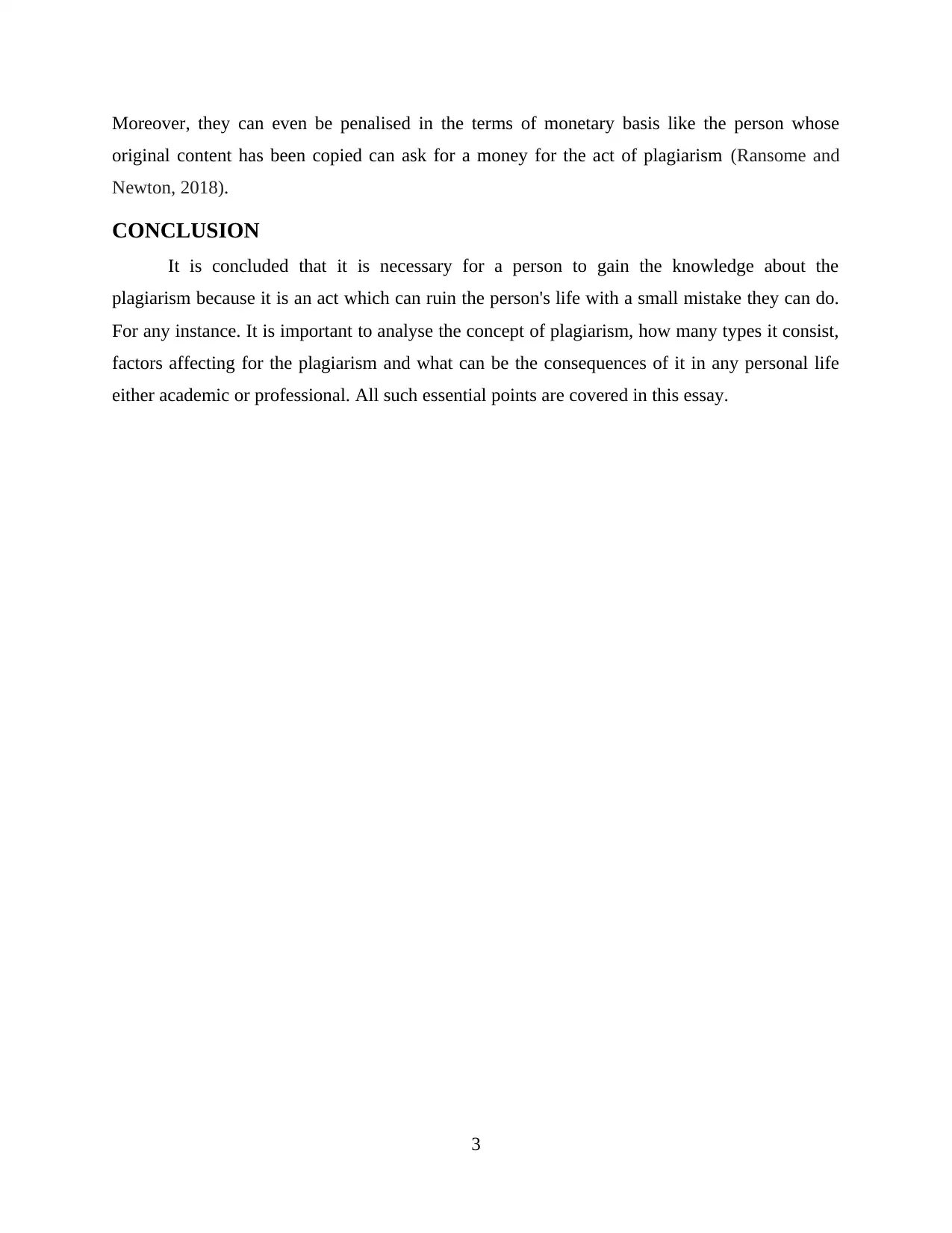
Moreover, they can even be penalised in the terms of monetary basis like the person whose
original content has been copied can ask for a money for the act of plagiarism (Ransome and
Newton, 2018).
CONCLUSION
It is concluded that it is necessary for a person to gain the knowledge about the
plagiarism because it is an act which can ruin the person's life with a small mistake they can do.
For any instance. It is important to analyse the concept of plagiarism, how many types it consist,
factors affecting for the plagiarism and what can be the consequences of it in any personal life
either academic or professional. All such essential points are covered in this essay.
3
original content has been copied can ask for a money for the act of plagiarism (Ransome and
Newton, 2018).
CONCLUSION
It is concluded that it is necessary for a person to gain the knowledge about the
plagiarism because it is an act which can ruin the person's life with a small mistake they can do.
For any instance. It is important to analyse the concept of plagiarism, how many types it consist,
factors affecting for the plagiarism and what can be the consequences of it in any personal life
either academic or professional. All such essential points are covered in this essay.
3
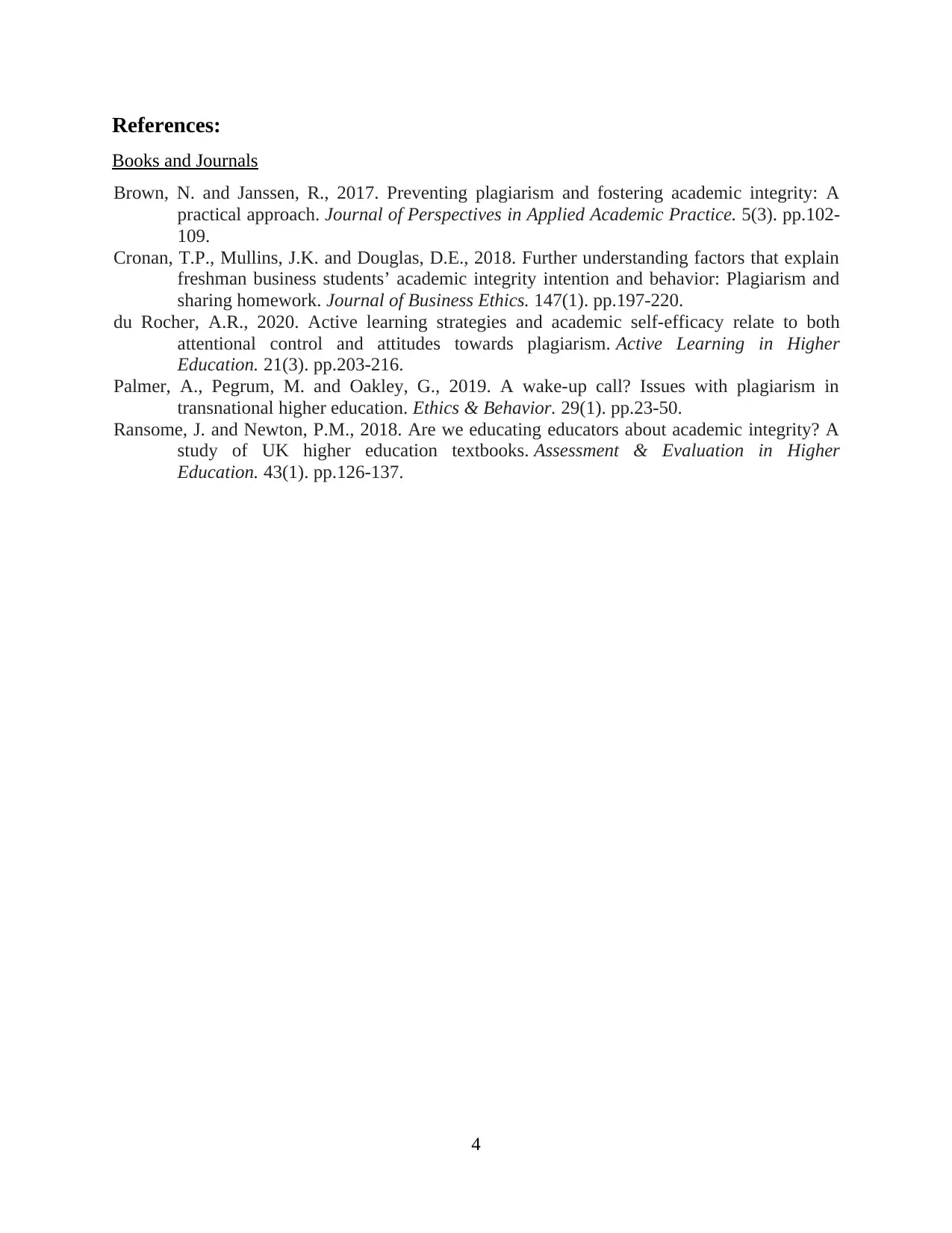
References:
Books and Journals
Brown, N. and Janssen, R., 2017. Preventing plagiarism and fostering academic integrity: A
practical approach. Journal of Perspectives in Applied Academic Practice. 5(3). pp.102-
109.
Cronan, T.P., Mullins, J.K. and Douglas, D.E., 2018. Further understanding factors that explain
freshman business students’ academic integrity intention and behavior: Plagiarism and
sharing homework. Journal of Business Ethics. 147(1). pp.197-220.
du Rocher, A.R., 2020. Active learning strategies and academic self-efficacy relate to both
attentional control and attitudes towards plagiarism. Active Learning in Higher
Education. 21(3). pp.203-216.
Palmer, A., Pegrum, M. and Oakley, G., 2019. A wake-up call? Issues with plagiarism in
transnational higher education. Ethics & Behavior. 29(1). pp.23-50.
Ransome, J. and Newton, P.M., 2018. Are we educating educators about academic integrity? A
study of UK higher education textbooks. Assessment & Evaluation in Higher
Education. 43(1). pp.126-137.
4
Books and Journals
Brown, N. and Janssen, R., 2017. Preventing plagiarism and fostering academic integrity: A
practical approach. Journal of Perspectives in Applied Academic Practice. 5(3). pp.102-
109.
Cronan, T.P., Mullins, J.K. and Douglas, D.E., 2018. Further understanding factors that explain
freshman business students’ academic integrity intention and behavior: Plagiarism and
sharing homework. Journal of Business Ethics. 147(1). pp.197-220.
du Rocher, A.R., 2020. Active learning strategies and academic self-efficacy relate to both
attentional control and attitudes towards plagiarism. Active Learning in Higher
Education. 21(3). pp.203-216.
Palmer, A., Pegrum, M. and Oakley, G., 2019. A wake-up call? Issues with plagiarism in
transnational higher education. Ethics & Behavior. 29(1). pp.23-50.
Ransome, J. and Newton, P.M., 2018. Are we educating educators about academic integrity? A
study of UK higher education textbooks. Assessment & Evaluation in Higher
Education. 43(1). pp.126-137.
4
⊘ This is a preview!⊘
Do you want full access?
Subscribe today to unlock all pages.

Trusted by 1+ million students worldwide
1 out of 6
Related Documents
Your All-in-One AI-Powered Toolkit for Academic Success.
+13062052269
info@desklib.com
Available 24*7 on WhatsApp / Email
![[object Object]](/_next/static/media/star-bottom.7253800d.svg)
Unlock your academic potential
Copyright © 2020–2025 A2Z Services. All Rights Reserved. Developed and managed by ZUCOL.





